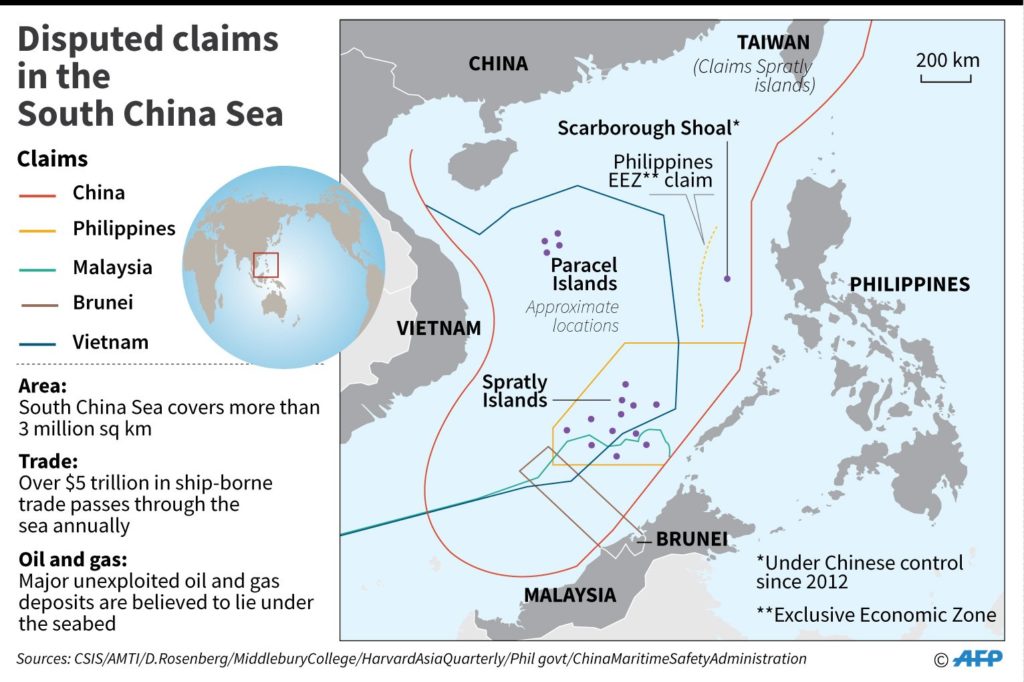MANILA, Philippines—While the world is turning topsy turvy over the novel coronavirus 2019 (COVID-19) pandemic that started in China, it’s still business as usual for the Asian giant in the West Philippine Sea (South China Sea).
Two research stations were recently launched on two of China’s large man-made islands in the West Philippine Sea — Kagitingan (Fiery Cross) and Zamora (Subi) Reef, Chinese news agency Xinhua reported on March 20.
The research facilities, which are under the Integrated Research Center for Islands and Reefs of the Chinese Academy Sciences (CAS), feature a number of labs on ecology, geology and environments, the report said.
These can support scientists in field investigation, sampling and scientific research in the Spratlys,a volatile region crisscrossed by maritime territorial disputes.
“An integrated scientific research base on coral reef and deep-sea” has now been set up in the two research stations now in operation, plus a previously-established research center on Panganiban (Mischief) Reef, said a Chinese source quoted in the report.
The bases are envisioned as support facilities for “interdisciplinary research of oceanographers.”
They were also designed to “improve the in-situ observation and experimental capabilities on ecology, geology, environments, materials and marine energy utilization in the tropical marine environment,” the Xinhua report said.
“The research conditions and facilities will be further optimized for better support,” the report said.
The CAS planned to “promote innovation capability and the supply of public service products of marine science and technology to meet the needs of both China and other littoral countries around the South China Sea.”
CAS, which was established to solve science and technology problems in the South China Sea, believes it would be contributing to the emergence of a maritime community with supposedly shared resources.
China in recent years had transformed reefs and islands into outposts equipped with harbors, airstrips, missile shelters, communications facilities, expanding its ability to monitor its and rivals’ activities in the South China Sea, which Beijing claims to almost entirely own.
Aside from the Philippines and China, Vietnam, Malaysia, Brunei, and Taiwan also have claims in the South China Sea, which is dotted by vital sea-lanes through which $5 trillion in global commerce passes every year and where islets, reefs, and atolls are believed to be sitting atop vast energy reserves.
Maritime expert Collin Koh said the launching of two new research centers by China at this time is a significant development.
“Some may think that the ongoing coronavirus pandemic would have distracted Beijing from these maritime flashpoints,” Koh told INQUIRER.net.
“Truth is, this is far from the case. The PLA (People’s Liberation Army) is touted to remain combat ready despite the coronavirus,” he said.
“Using these supposedly ‘civilian scientific’ endeavors to assert claim is one such modus operandi, and one that’s also often overlooked by all of us,” he said.
“Yet at the same time, the resulting strategic ramifications are not any less insignificant,” he said.
Koh believes China will remain consistent in its activities in the disputed waters. However, because of the pandemic that has swept across the globe, its actions might go unnoticed.
“The world is likely to overlook such developments given their priority focus on the virus. This should apply to the other South China Sea parties too,” Koh said.
“Any PLA letup, or for that matter letup by Beijing in pushing its maritime sovereignty and rights in the South China Sea, amid the coronavirus would send a wrong signal to both domestic and external audiences,” he said.
The expert said China’s continued proactiveness in the South China Sea despite grappling with the coronavirus was evident after it was the first to publicize a US freedom of navigation exercise in the Paracels on March 10. The US usually reports its own freedom of navigation operations.
Edited by TSB
